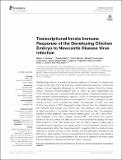| dc.description.abstract | Traditional approaches to assess the immune response of chickens to infection are
through animal trials, which are expensive, require enhanced biosecurity, compromise
welfare, and are frequently influenced by confounding variables. Since the chicken
embryo becomes immunocompetent prior to hatch, we here characterized the
transcriptional response of selected innate immune genes to Newcastle disease virus
(NDV) infection in chicken embryos at days 10, 14, and 18 of embryonic development.
The results suggest that the innate immune response 72 h after challenge of 18-day
chicken embryo is both consistent and robust. The expression of CCL5, Mx1, and
TLR3 in lung tissues of NDV challenged chicken embryos from the outbred Kuroiler
and Tanzanian local ecotype lines showed that their expression was several orders
of magnitude higher in the Kuroiler than in the local ecotypes. Next, the expression
patterns of three additional innate-immunity related genes, IL-8, IRF-1, and STAT1,
were examined in the highly congenic Fayoumi (M5.1 and M15.2) and Leghorn
(Ghs6 and Ghs13) sublines that differ only at the microchromosome bearing the major
histocompatibility locus. The results show that the Ghs13 Leghorn subline had a
consistently higher expression of all genes except IL-8 and expression seemed to be
subline-dependent rather than breed-dependent, suggesting that the innate immune
response of chicken embryos to NDV infection may be genetically controlled by the
MHC-locus. Taken together, the results suggest that the chicken embryo may represent
a promising model to studying the patterns and sources of variation of the avian innate
immune response to infection with NDV and related pathogens. | en_US |

